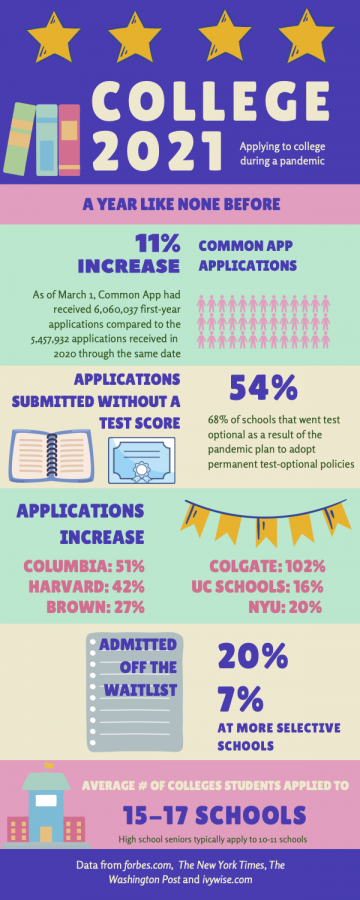How the pandemic permanently changed the college application process
This year, selective universities saw a surge in applications: Yale saw a 33 percent increase in applications, Harvard saw a 43 percent increase and Colgate saw a 102 percent increase. Accordingly, the admission rates to these schools were lower than ever before. According to ingeniusprep.com, MIT’s acceptance rate went from 7.3 percent to 4 percent. Vanderbilt University dropped from 9 percent to 6.7 percent, and Columbia went from an acceptance rate of 6.1 percent to 3.7 percent.
So, what accounts for this increase in applications but a decrease in admissions? Answer: The pandemic. The combination of schools going test-optional and the inability to visit colleges in person caused more students to apply to prestigious universities, but a smaller percentage to get in.
The largest factor in this new trend in admissions is that most universities adopted a test-optional policy this year. Many students did not have the same opportunities to take the SAT or ACT this year, so many schools did not require applicants to send a test score with their application.
For many, especially low-income and first-generation students unable to afford tutors or test preparatory classes, standardized test scores were an obstacle preventing them from admission to selective colleges. Even if their GPA, recommendations and extracurriculars made them a competitive applicant, without high test scores, it seemed pointless to apply. “In the past, if a student could not achieve a certain ACT or SAT score, that student would see that as a barrier to entry and might not apply,” said WHS Guidance Counselor Andrew Buckner.
Without test scores holding students back, getting into top-tier universities appeared to be more achievable. WHS senior Ryleigh Gildea said, “I applied test-optional to most of my reach schools since I was only able to take the SAT once, and the score I got was not as high as some of the schools accepted in the past.”
Additionally, the inability for students to tour campuses altered the number of schools to which they applied. According to the This American Life podcast “The Campus Tour Has Been Cancelled,” in an average year, seniors applied to 10-11 schools, but this year, that number rose to 15-17 schools.
Without the opportunity to visit a school in person, students did not know what type of school they wanted and were unable to cross certain ones off their application lists. “Some students felt less confident about which colleges would be a good fit for them, and so they applied to more colleges to keep their options open,” said Marina McClure, Director of College Admissions at Private Prep.
This was certainly the case for WHS senior Katie Leary. “If I was able to tour schools last spring, I would have only applied to around 7 schools, but I ended up applying to 17,” said Leary. “I literally had no idea what any of the schools were about and wanted to keep my options open.”
The test-optional policy combined with the inability to visit schools caused prestigious universities to have larger, more competitive application pools. The more people who applied, the harder it became to get accepted to a selective university.
With more applications, admissions officers had more difficulty deciding who to accept. Universities care about yield protection: they only want to admit students whom they know will attend. Before COVID-19, going on a college tour or meeting with an admissions counselor for an interview were ways to demonstrate interest and prove to a university that they were a top choice. However, these options were no longer available, and since students applied to more universities this year, it was harder for schools to track demonstrated interest and protect their yield.
For this reason, the number of students put on colleges’ waitlists grew. An article from College Confidential explained, “Many schools put more qualified students on their waitlists to be sure they have a solid group to reach out to if fewer admitted students accept their admissions offers this year.”
Many predict that the changes to the college application process that took place this past year will continue in years to come. According to the 2020 Inside Higher Ed survey of admissions officials, 68 percent of schools that adopted a test-optional policy because of the pandemic, plan to keep these policies in place.
Rita Murphy, a Senior Admissions Counselor at the Catholic University of America, said, “Virtual information sessions, tours, meetings and interviews allow for so much flexibility and accessibility, so I think schools will continue to offer these opportunities. The college admission process will definitely never be the same, but it has hopefully been changed for the better.”

